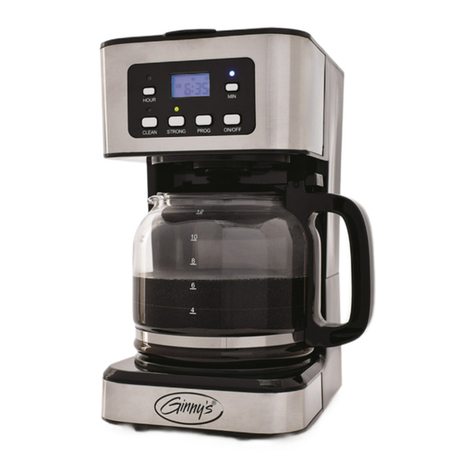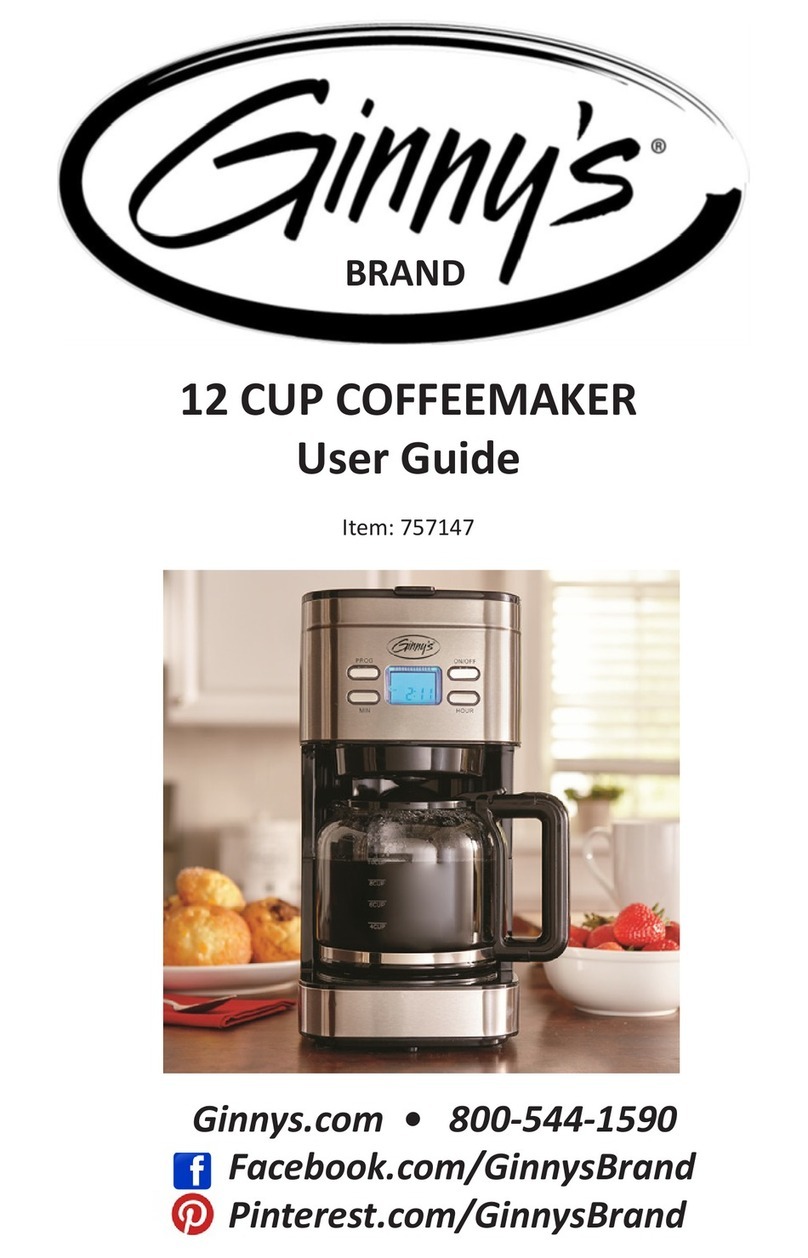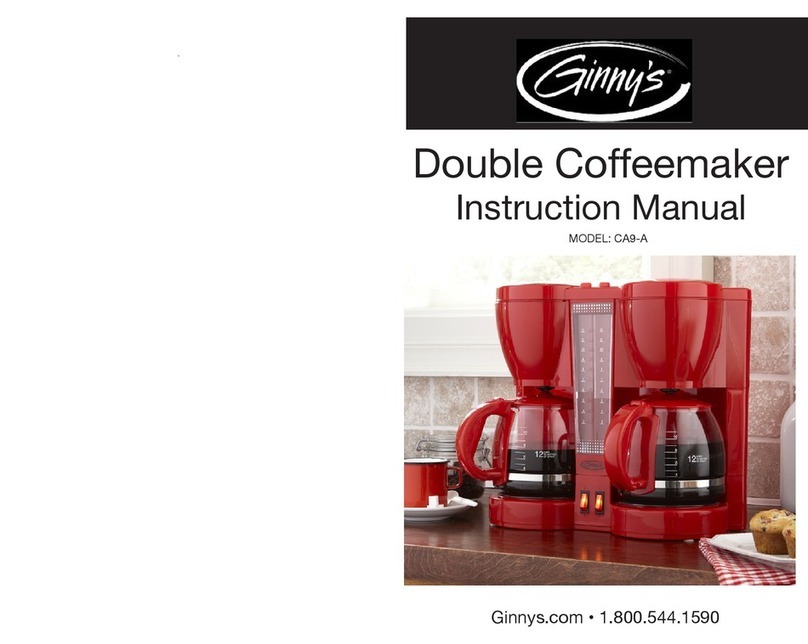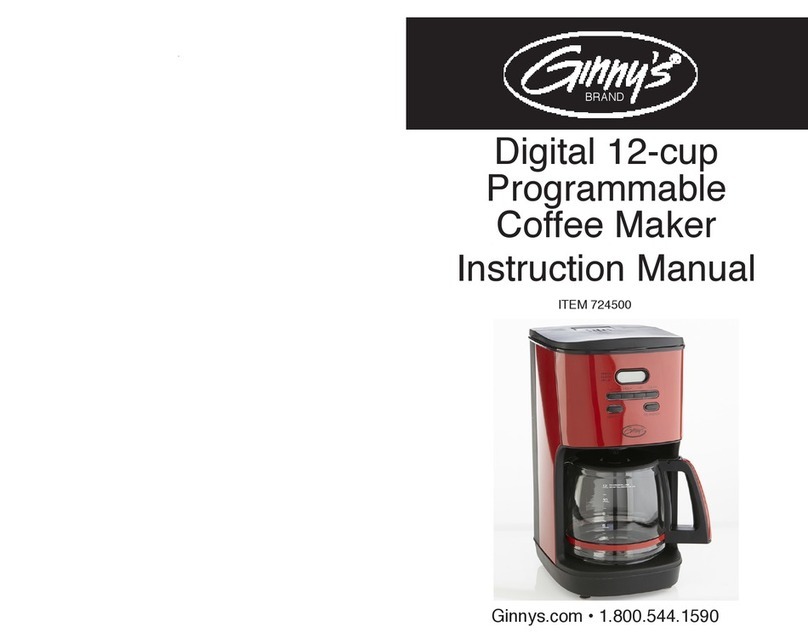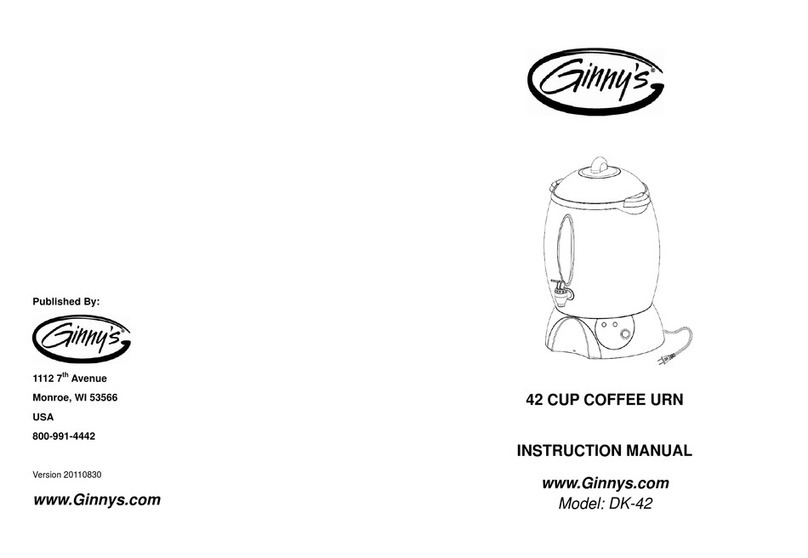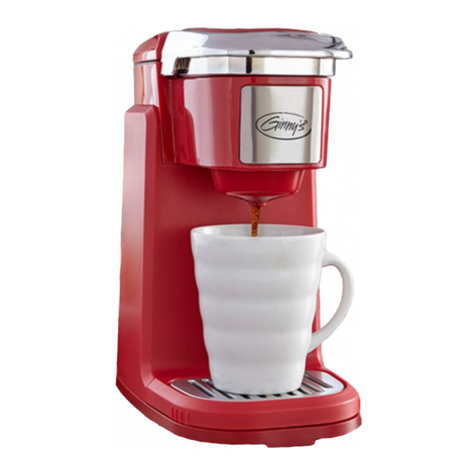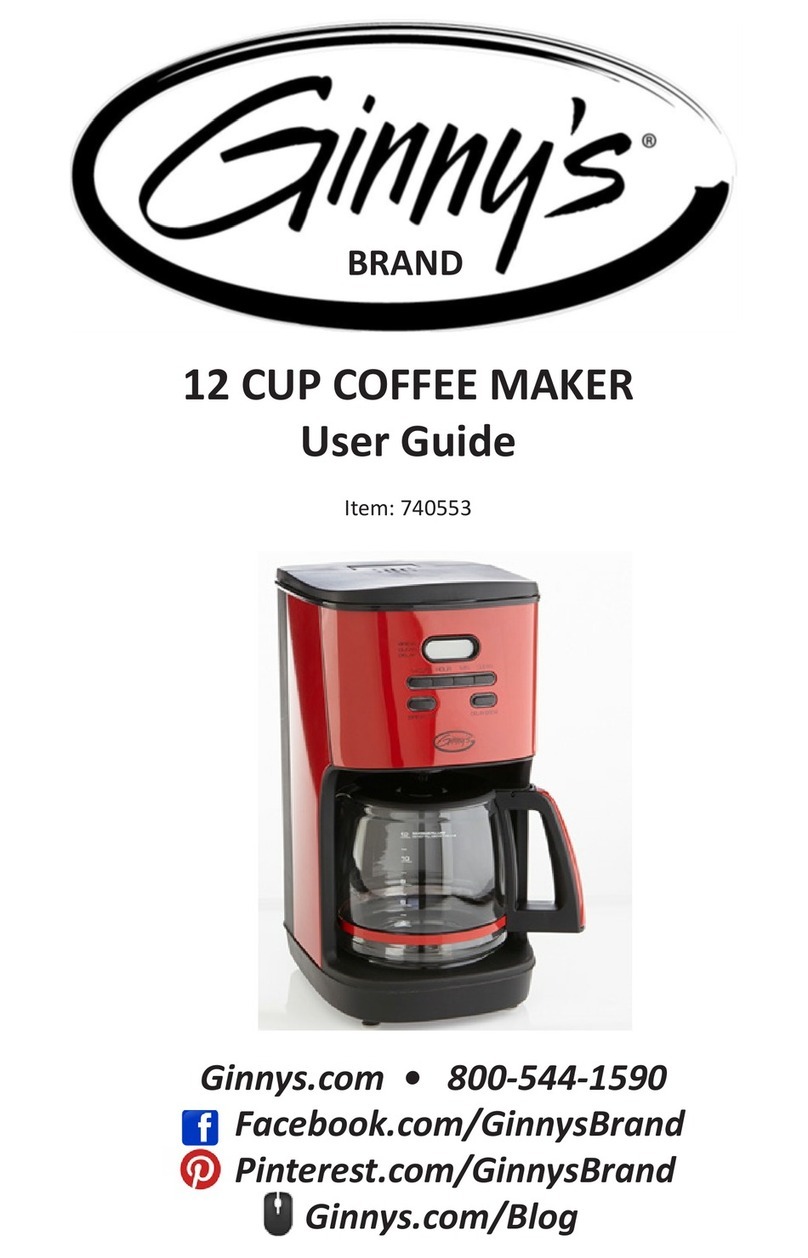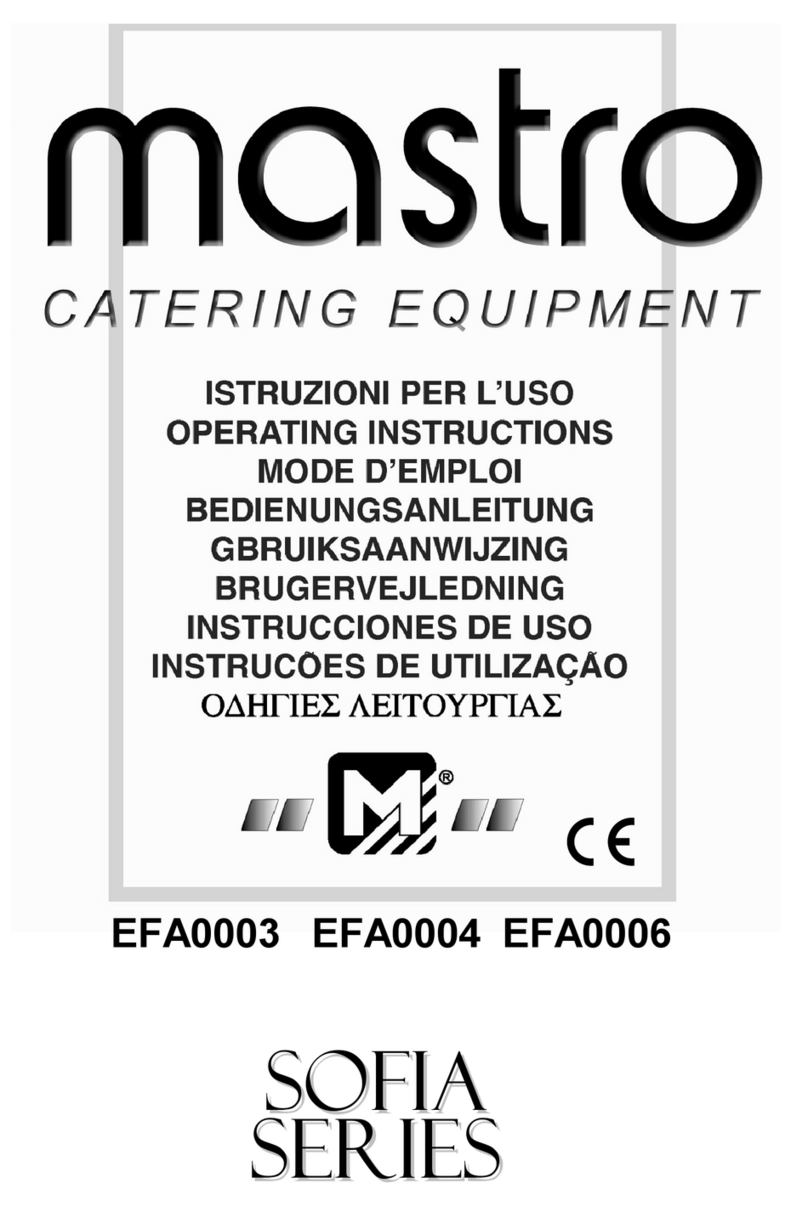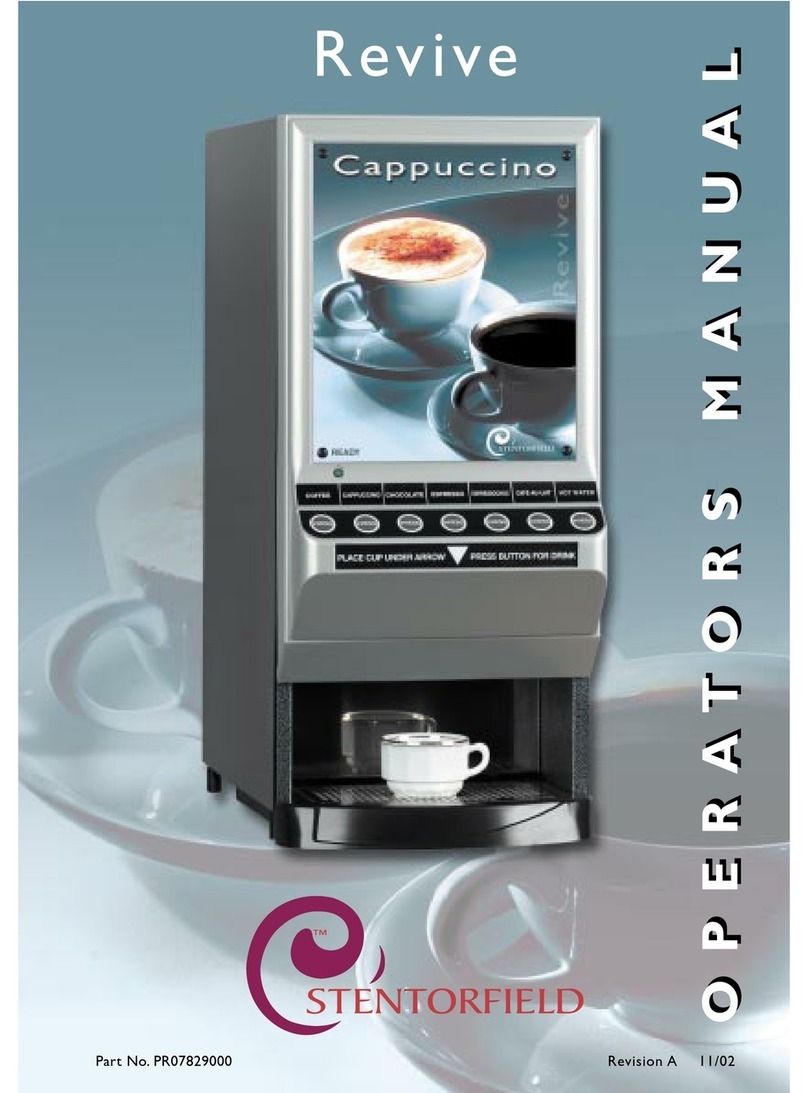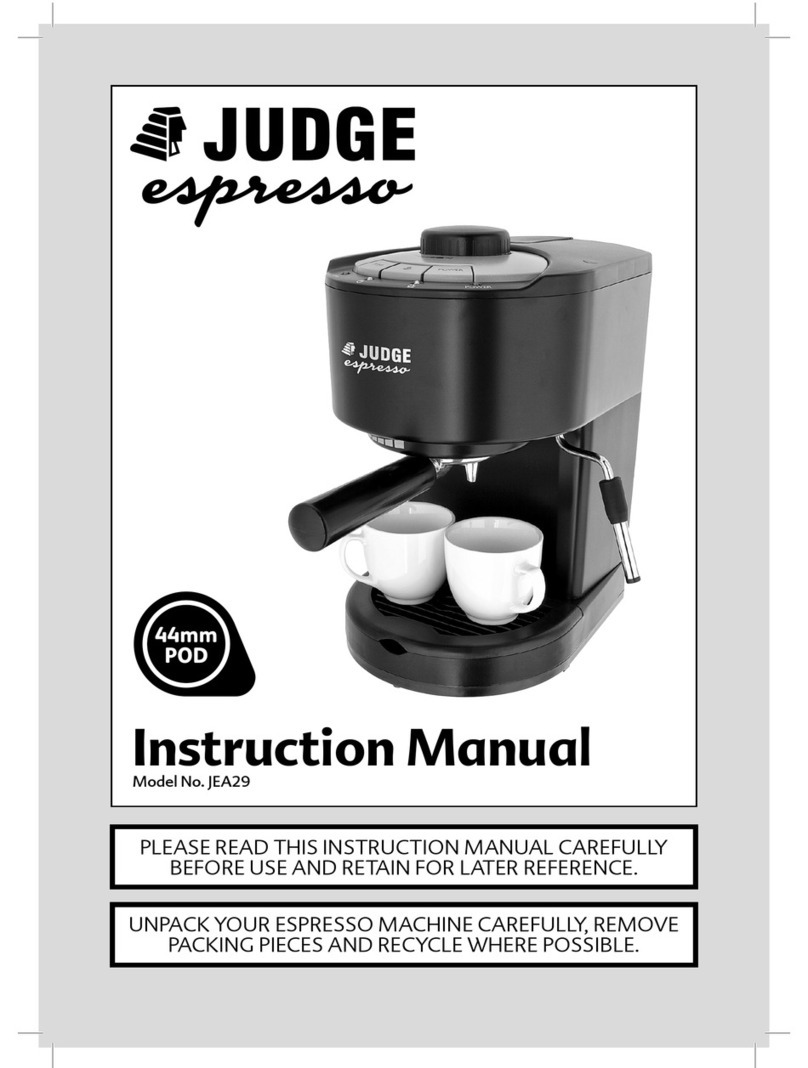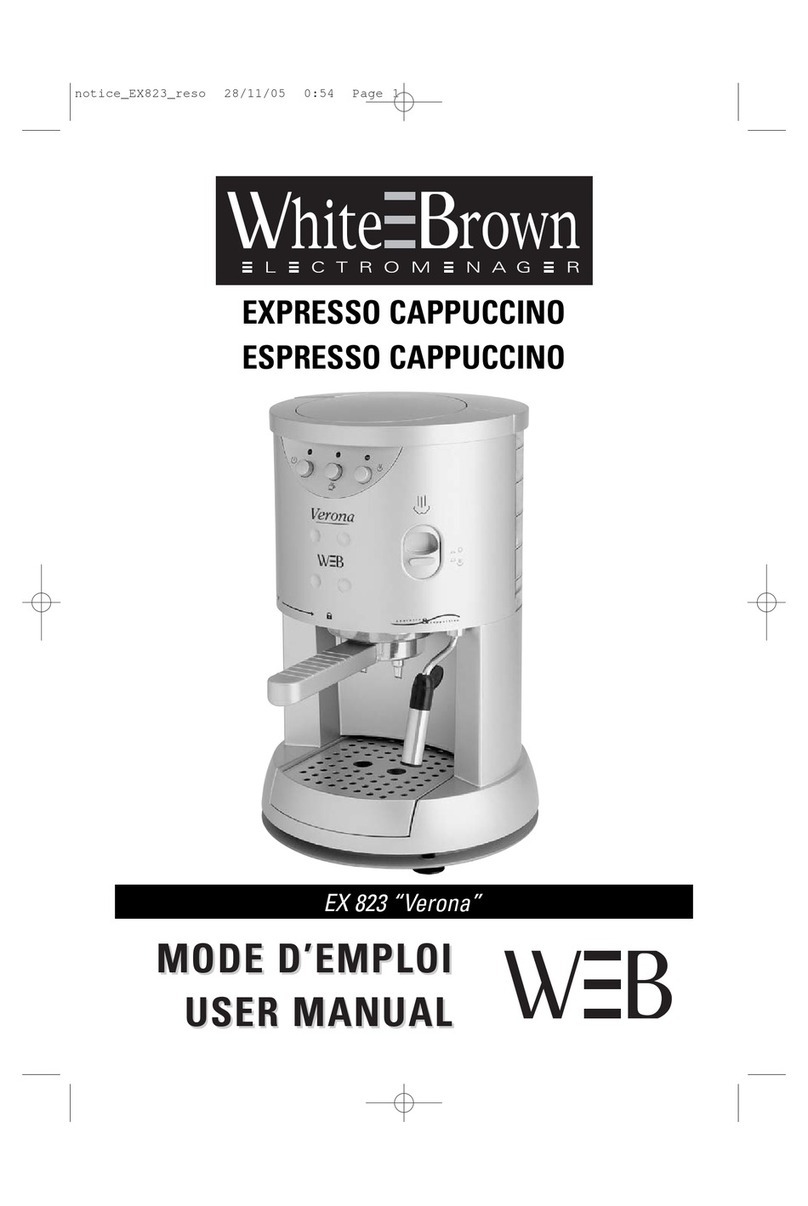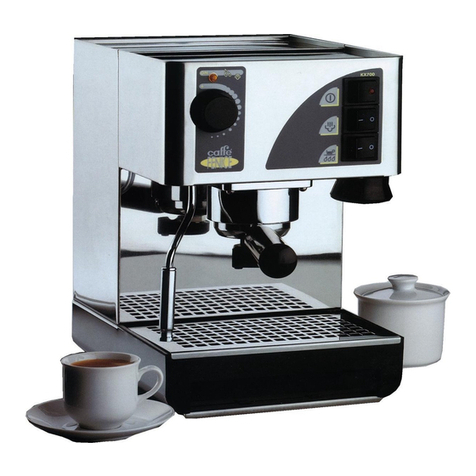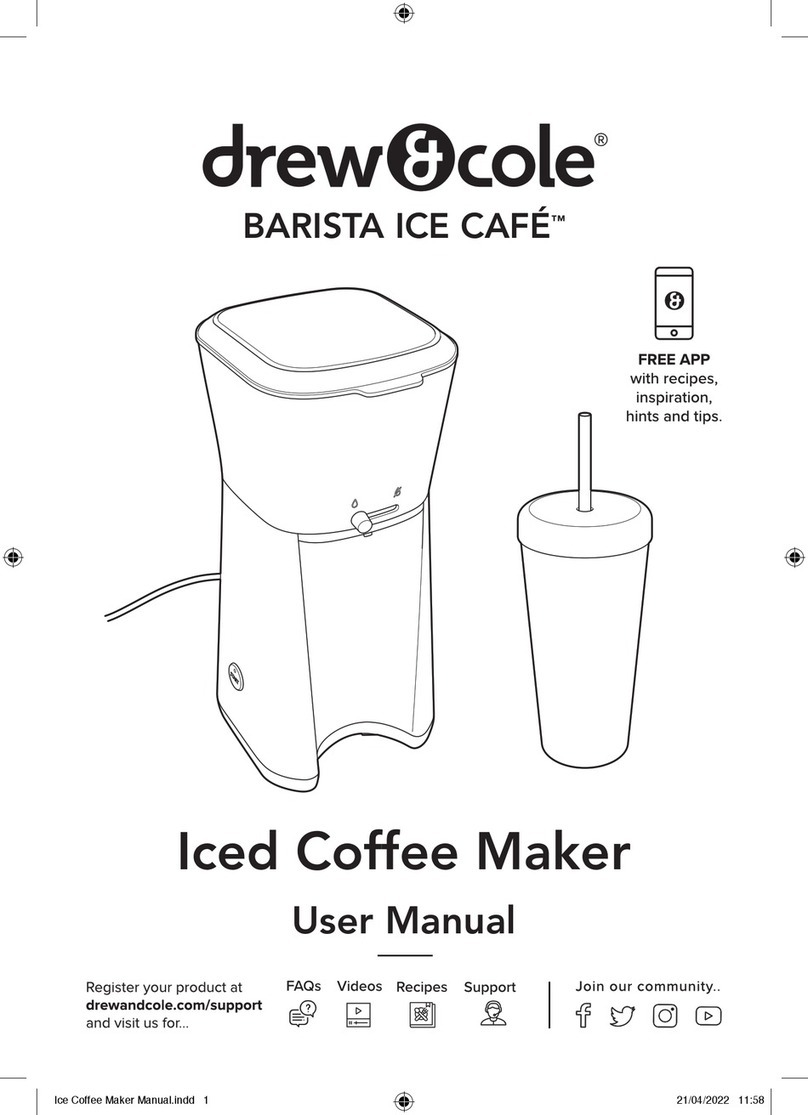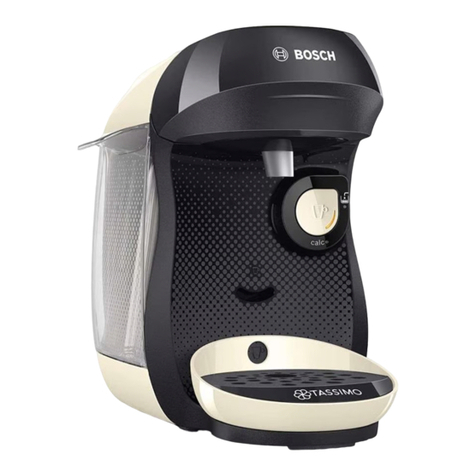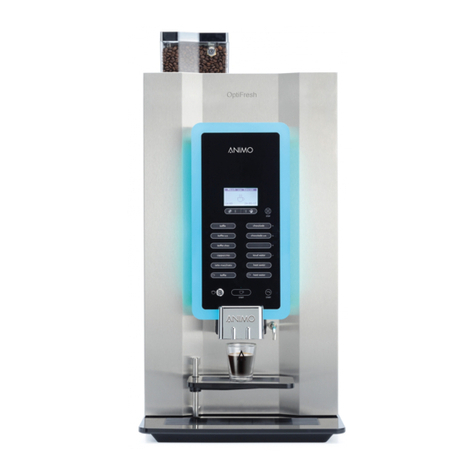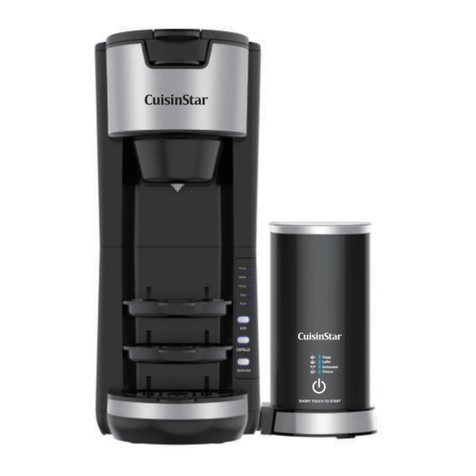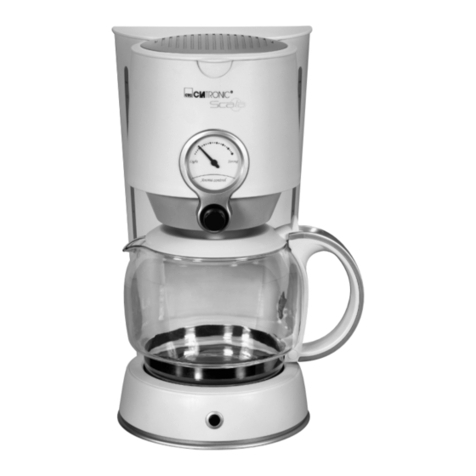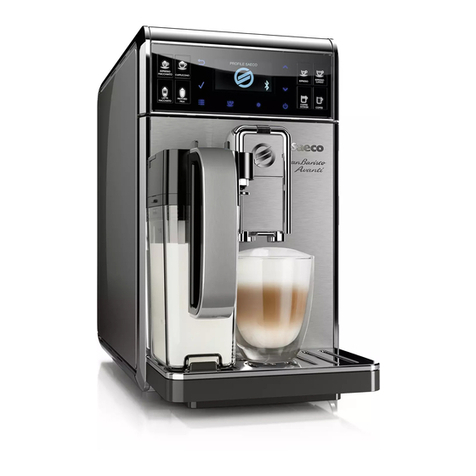Ginnys HY-5201 User manual

1 YEAR LIMITED WARRANTY
Ginny’s warrants this product free from defects in material and
workmanship for one year from provable date of purchase.
Within this warranty period, Ginny’s will repair or replace, at its option,
defective parts at no charge, provided the product is returned, freight
prepaid with proof of purchase to Ginny’s. Allow 2-4 weeks for return
shipping.
This warranty does not cover improper installation, misuse, abuse or
neglect on part of the owner. Warranty is also invalid in any case that the
product is taken apart or serviced by an unauthorized service station.
This warranty gives you specific legal rights and they may vary from state
to state.
THE FOREGOING WARRANTIES ARE IN LIEU OF ALL OTHER WARRANTIES
AND CONDITIONS, EXPRESS OR IMPLIED, INCLUDING BUT NOT LIMITED
TO THOSE OF MERCHANTIBILITY OR FITNESS FOR A PARTICULAR
PURPOSE.
GINNY’S Customer Returns
Phone: 800-991-4442
8:00 am to Midnight, Monday through Friday.
www.ginnys.com
Espresso/Cappuccino/Single Serve
Coffee Maker
HY-5201
Instruction Manual

IMPORTANT SAFEGUARDS
When using electrical appliances, basic safety precautions should always be followed
to reduce the risk of fire, electric shock and/or injury to persons, including the
following:
1. READ ALL INSTRUCTIONS BEFORE USING THE MACHINE.
2. Do not touch hot surfaces. Use handles or knobs.
3. To protect against electric shock, do not immerse cord, plugs or machine in water
or other liquids.
4. This product is not recommended for use by children.
5. Turn control knob to “OFF” and unplug from electrical outlet when not in use and
before cleaning. Allow to cool before putting on or taking off parts and before
cleaning the appliance.
6. Do not operate any appliance with a damaged cord or plug or after the appliance
malfunctions of has been damaged in any manner. Contact Ginny’s customer
returns for further instructions.
7. The use of accessory attachments not recommended may cause hazards or
injuries.
8. Do not use outdoors.
9. Do not let cord hang over edge of table or countertop or touch hot surfaces.
10. Do not place this appliance on or near a hot gas or electric burner or in a heated
oven.
11. To disconnect, turn control knob to “OFF”, then remove plug from wall outlet.
12. Do not use appliance for anything other than its intended use.
13. Use on a hard, flat, level and heat resistant surface only, to avoid interruption of
air flow underneath the appliance.
14. Always be sure water reservoir cap is tightened securely before turning appliance
on.
15. DO NOT remove reservoir cap or brew basket until pressure is completely
relieved. See section “CAUTION:PRESSURE”
16. CARAFE USE AND CARE
Breakage may occur if the following instructions are not followed:
a. This carafe is designed for use with your Espresso/Cappuccino Maker and
therefore must never be used on a range-top or in any oven, INCLUDING
MICROWAVE.
b. Do not set a hot carafe on a wet or cold surface.
c. Do not use a cracked carafe or a carafe with a loose or weakened handle.
d. Do not clean the carafe with cleansers, steel wool pads or other abrasive
materials.
e. Discard carafe immediately if it is ever boiled dry.
f. Avoid sharp blows, scratches or rough handing.
17. WARNING: To reduce the risk of fire or electric shock, do not remove any
service covers. No user serviceable parts inside. Repair should be done by
authorized personnel only. Opening the bottom service cover will void the
warranty.
SAVE THESE INSTRUCTIONS!
CONSUMER SAFETY INFORMATION
NOTE: For best results, allow the Espresso/Cappuccino Maker to cool for 60 seconds
between brewing cycles.
CAUTION: PRESSURE
In order to check if the appliance is under pressure, follow these steps:
1. Turn the control knob to the “OFF” position and unplug the appliance.
2. Rotate the control knob to the “STEAM” position. If steam comes out of the
frothing tube, then the water reservoir is still under pressure.
3. To release the pressure, hold a pitcher with water under the frothing tube
and immerse the frothing aid in the water. SLOWLY TURN THE
CONTROL KNOB TO THE “STEAM” POSITION AND RELEASE THE
STEAM.
4. W hen the frothing tube stops releasing steam, turn to the “OFF” position
and slowly remove the cap.
5. Do not remove the brew basket at any time during the brewing process or
until pressure is relieved.
6. Use caution when removing the brew basket. The metal parts may still be
very hot. Also, there may be not water floating on the top of the filter.
7. If coffee does not drip from basket, the brew basket is blocked. Allow the
appliance to cool down, then release the steam with the instructions above.
The blockage may be caused by too finely ground coffee. See
“PROBLEMS AND CAUSES”.
8. WHEN CLEANING THE FROTHING AID: Place a frothing pitcher or large
cup (with at least an 11 ounce capacity) half full of water under the frothing
aid. Make sure the tip of the frothing tube is submerged in liquid before
turning the control knob to the “STEAM” position.
In order for your unit to work properly time after time,
Clean the frother after each use.
w w w . g i n n y s . c o m
w w w . g i n n y s . c o m

PARTS & FEATURES
HOW TO PREPARE QUALITY ESPRESSO
AND CAPPUCCINO AT HOME
The coffee should be freshly ground, dark roasted variety. You may want to try a
French or Italian roast. Pre-ground coffee will only retain its flavor for 7-8 days,
provided it is stored in an air-tight container, in a cool, dark area. Do not store in a
refrigerator or freezer.
Whole beans are recommended, to be ground just before use. Coffee beans stored in
an air-tight container will keep up to 4 weeks before they begin to lose their flavor.
The Coffee Grind
This is a vital step in the espresso making process and takes practice. The coffee
must be of a fine grind.
1. The correct grind should look like salt.
2. If the grind is too line, the water will not flow through the coffee even under
pressure. This grind looks like powder and feels like flour when rubbed between
fingers.
3. If the grind is too coarse, the water flows through the coffee too fast, preventing a
full-flavored extraction.
BEFORE BREWING YOUR FIRST CARAFE OF ESPRESSO
Please refer to diagram of parts.
1. Turn the control knob to the “OFF” position and make sure that the appliance is
unplugged from the electrical outlet.
2. First remove and then wash the carafe, lid, filter and brew basket in a mixture
of mild detergent and water. Rinse each thoroughly and replace into the
machine. See “how to brew espresso” below for instructions on removal and
replacement of filter and brew basket.
3. To clean the inside of the machine, follow steps for “how to brew espresso”
below.
w w w . g i n n y s . c o m
w w w . g i n n y s . c o m

HOW TO BREW ESPRESSO
1. Turn the control knob to the “OFF” position.
2. Fill the glass carafe with cold water to the designated marking for the desired
number of serving of espresso or cappuccino. Never use warm or hot water to
fill the water reservoir. The following chart describes how much water to use
for the desired amount of servings.
NOTE: One serving or shot of espresso equals 2 ounces.
SERVINGS
ESPRESSO
CAPPUCCINO
2
2 cup marking on carafe
Midpoint between 2 and 4 cup mark
on carafe
4
4 cup marking on carafe
Top of metal band on carafe
3. Remove the water reservoir cap and pour the water into the water reservoir. Be
sure to accurately measure the amount of water needed. Do not fill to the top of
the reservoir or there will not be enough area to generate steam.
CAUTION: Do not pour water into the tank while the appliance is on. Check to
make sure the control knob is in the “OFF” position.
4. Screw the cap back on top of the water reservoir. Make sure it is on tight.
PREPARING THE COFFEE
1. Place the filter in the brew basket.
2. Fill with fresh, fine ground espresso coffee to the 2 or 4 cup mark of the filter. Do
not fill above the 4 cup markings. Clean any excess coffee from the rim of the
filter holder. Thos will assure proper fit under the brew head.
ATTENTION:
Gently tamp or compress coffee. Do not overfill the filter basket.
This might cause clogging or overflow.
3.Position brew basket underneath the brew head, attach brew basket by first moving
retainer clip back, position handle to far left until it fits into the groove. Then, slowly
turn to right until brew basket is located at lock position.
BREWING THE ESPRESSO
ATTENTION: IF YOU ARE PLANNING TO MAKE CAPPUCCINO, PLEASE REFER
TO THE NEXT SECTION “HOW TO MAKE CAPPUCINO.”
1. Make sure the drip grid is in place on the drip tray.
2. Place the cover on the carafe so the lid opening faces the spout, and it on the
drip tray. The handle of the brew basket and the handle of the decanter should
be in alignment.
3. Make sure the control knob is in the “OFF” position.
4. Plug the power cord into an electrical outlet and rotate the control knob upward to
the symbol, which begins the brewing process. The light will illuminate to
let you know that the machine is on.
5. Espresso will begin to flow into the carafe in about three to five minutes.
6. When the espresso has stopped flowing into the carafe, turn thee control knob to
the “OFF” position. Unplug the power cord and allow the machine to cool. Do not
remove reservoir cap or brew basket until the pressure in the making has been
released. Follow procedures in the section marked “CAUTION: PRESSURE”.
Caution: Do not remove reservoir cap or brew basket at any time while the
appliance is under pressure or until the appliance has cooled down. Follow the
procedures marked “CAUTION: PRESSURE” relieve the pressure before
removing the reservoir cap or brew basket.
7. After the machine has cooled down and all pressure has been relieved, remove
the brew basket from the brew head. Using the retainer clip to secure the filter
holder, turn the brew basket upside down to empty. Rinse the filter and brew
basket with water.
CAUTION: The metal parts of the brew basket might still be very hot. Make sure
to use the filter retainer clip when discarding the grounds. Cool these parts by
running under cold water.
HOW TO MAKE CAPPUCCINO
Cappuccino is espresso topped with steamed and frothed milk. Frothing milk for
cappuccino takes practice. Do not be discouraged if it is not perfect the first time. The
milk should be half steamed (bottom of pitcher) and half froth (top of pitcher). It may
take a few times before you perfect this process.
For best results, we recommend frothing the milk in a separate pitcher and pouring
the milk into your coffee. The milk and pitcher should be cold. Do not use a pitcher
which has just been washed in warm water. We also recommend a stainless steel
frothing pitcher and a beverage thermometer, if you own one, for preparing the best
froth and steamed milk.
1. The first step in making cappuccino is to make espresso. Therefore, fill the glass
carafe with cold water to the designated marking for the desired number of
servings. Never use warm or hot water to fill the water reservoir (see chart from
“how to brew espresso” )
2. Follow steps 1-5 in “brewing espresso”.
3. Fill a small stainless steel or ceramic pitcher 1/2 full with cold milk and milk and
set next machine. Skim or 2%milk will be the easiest to froth.
4. If making 2 servings, stop brewing espresso at the 2-4 and 4-cup mark. Turn the
control knob to the off position. If making 4 servings, stop brewing espresso at
the 4-cup mark. Turn the control knob to the off position.
5. You are now ready to froth and steam your milk. Hold the pitcher under the
frothing tube so that the frothing aid is slightly immersed in the milk. Turn the
control knob slowly to the “STEAM” position. Gently move the pitcher in a circular
motion around the steam nozzle for about 45 seconds. REMEMBER: the milk
www. g i n n y s . c o m
w w w . g i n n y s . c o m

and the pitcher should be very cold prior to frothing.
6. When the milk has doubled in volume, or, if you are using a beverage
thermometer, when the milk has reached 1000F, insert the frothing aid deeper
into the milk to further heat the milk. Do not heat milk above 1500F.
NOTE: To avoid splattering of hot milk, do not let the frothing aid go above the
surface of the milk. After frothing is completed, turn the control knob back the “OFF”
position.
7. You are now ready to make cappuccino. REMEMBER: it is 1/3 espresso, 1/3
steamed milk and 1/3 frothed milk. Pour the espresso into a cup which has the
capacity of at least 5 ounces. Then add the steamed milk to the espresso and
spoon on the frothed milk.
8. Follow the instructions on page 6 under section marked “CAUTION:
PRESSURE” to flush out any residual milk from the frothing use.
NOTE: It is important to properly clean your frothing tube after each use to ensure it
continues to work properly.
9. Unplug the power cord and allow the machine to cool. Do not remove the
reservoir cap or brew basket until the pressure in the machine has been
released. Follow procedures in section marked “CAUTION: PRESSURE” to
relieve the pressure.
CLEANING YOUR
ESPRESSO/CAPPUCCINO MAKER
1. Turn the unit to “OFF” and unplug the power cord from the electrical outlet.
2. The frothing tube may still be hot, do not touch if with your hands until it has
cooled. Remove frothing aid and wipe frothing tube with a damp cloth. Using the
wrench built into Remove frothing aid and clean valve with a needle or toothpick.
3. The carafe lid, carafe lid, filter, brew basket and drip tray can be washed with
soapy water or placed on the top rack only of your dishwasher. CAUTION: Do
not immerse appliance in water. Do not remove reservoir cap or brew basket
while appliance is under pressure.
4. After the pressure has been released, remove reservoir cap. Discard the
remaining water through the top opening of the water reservoir by turning the
appliance upside down over the sink. Always empty the water reservoir between
uses. Do not immerse appliance in water. Screw the reservoir cap back in place.
5. Wipe housing with a soft wet cloth. Do not use abrasive cleaners or scouring
pads as they will scratch the finish.
6. Do not store the filter holder in the brew head. This can adversely affect the
seal between the brew head and the filter holder while brewing espresso.
CARAFE CLEANING
Hard water can leave a whitish mineral deposit inside the carafe. Coffee discolors
these deposits, sometimes leaving a brownish stain inside the carafe. TO remove
these stains, follow these simple steps:
1. Use a solution of equal parts white vinegar and hot water.
2. Let solution stand in carafe for about 20 minutes and then discard.
3. Wash and rinse the carafe thoroughly using a soft cloth. Do not use harsh
abrasive cleaners. These may cause scratches which can lead to breakage.
DELIMING
Mineral deposits built-up in the Espresso maker will affect the operation of the
appliance. Your Espresso Maker must be when you begin to notice an increase in the
time to brew espresso, or when then is excessive steaming. Also, you may notice a
build up of white deposits on the surface of the brew head.
The frequency of cleaning depends upon the hardness of the water used. The
following table gives the suggested cleaning intervals.
SUGGESTED CLEANING INTERVAL
Type of water cleaning Frequency
Soft Water (Filtered Water) Every 80 Brew Cycles
Hard water (Tap Water) Every 40 Brew Cycles
w w w . g i n n y s . c o m
www . g i n n y s . c o m

YOUR ESPRESSO/CAPPUCINO MAKER MAY BE DELIMED
USING WHITE HOUSEHOLD VINEGAR, AS FOLLOWS:
TO DELIME WATER RESERVOIR:
1. Make sure the control knob is in the “OFF” position and that the power cord is
disconnected from the electrical outlet.
2. If the appliance is cool and the pressure has been released, (See section
“CAUTION: PRESSURE”) remove the reservoir cap and fill reservoir with fresh,
undiluted white household vinegar.
3. Allow appliance to sit overnight with the vinegar solution in the water reservoir.
4. Discard vinegar through the top opening of the Espresso Maker by turning the
machine upside down over the sink.
5. Rinse the water reservoir thoroughly with tap water by filling tank half full with
water and then pouring the water back out into the sink, repeating this step twice.
TO DELIME INTERNAL PARTS:
1. Make sure you delime the inside of the water reservoir first by following the
“Deliming ” steps above.
2. Make sure all controls are “OFF”, the power cord is disconnected from the
electrical outlet, the appliance is cool and all pressure in the appliance has been
released. (See Section “CAUTION:PRESSURE” ) Fill carafe to the top of the
metal band with vinegar and pour into reservoir.
3. Screw the cap back on top of the water reservoir. Make sure the cap is on tight.
4. Insert the brew basket (with filter) and place the glass carafe with lid on the drip
tray.
5. Plug the power cord into the electrical outlet.
6. Turn the control knob to the position. When vinegar begins to flow into the
carafe, place a cup with cold water under the frothing aid. Insert the frothing tube
into the water and slowly turn the control knob to the “STEAM” position. After ten
seconds turn the control knob to the “OFF” position. This will clean any residue
left in the frothing tube from frothing milk.
7. Turn the control knob to the position. When all the vinegar has been
pumped into the carafe and the flow has stopped, turn the control knob to “OFF”
and allow the appliance to cool.
8. Repeat Steps 1-7 using only tap water to rinse any remaining traces of vinegar
out of the machine. Repeat this rinsing process, allowing the machine to cool and
pressure to be released before each rinsing.
TROUBLESHOOTING
PROBLEM CAUSES SOLUTIONS
Coffee does
Not come out
No water in reservoir
Coffee grind is too fine
Too much coffee in the filter
Cap is not secure, steam is
escaping.
Appliance was not turned on or
plugged in
Coffee has been tamped/
compressed too much
Add water
Grind coffee medium ground
Fill filter only to 4 cup mark
Tighten cap
Plug unit into electrical
outlet.
Turn on
Refill filter basket with
coffee. DO NOT TAMP
Coffee comes
out around
The edge of the
filter holder
Filter holder not rotated to full
lock position
Coffee grounds around the
filter basket rim
Too much coffee in the filter
basket
Rotate filter holder to full lock
Wipe off rim; fill only to 4 cup
mark
Fill only to 4 cup mark
No steam is
generated
Water reservoir is empty
Too much water in the
reservoir-no room for steam
Appliance is not turned on
Frothing rube is blocked
Fill reservoir with correct
amount of water.
Empty some water from
reservoir.
Turn on unit with control
knob
Following frothing stage,
operate frothing function for
1-2 seconds to extract
excess milk. Or, turn off unit,
allow unit to cool, unplug unit
and clean out frothing tube
with a needle or toothpick.
Milk is not foamy
after frothing
Ran out of steam
Milk is not cold enough
Pour in the required amount
of water to make
cappuccino.
Chill milk and frothing pitcher
prior to making cappuccino.
Chill milk and frothing pitcher
prior to making cappuccino
Coffee comes
out too quickly
Ground coffee is too coarse
Not enough coffee in filter
basket
Use a finer grind
Use more coffee
Coffee is
splattering out of
frothing tube
Water tank is empty or low, not
enough pressure
Once unit has cooled, use
more water to brew espresso
w w w . g i n n y s . c o m
w w w . g i n n y s . c o m
Table of contents
Other Ginnys Coffee Maker manuals
